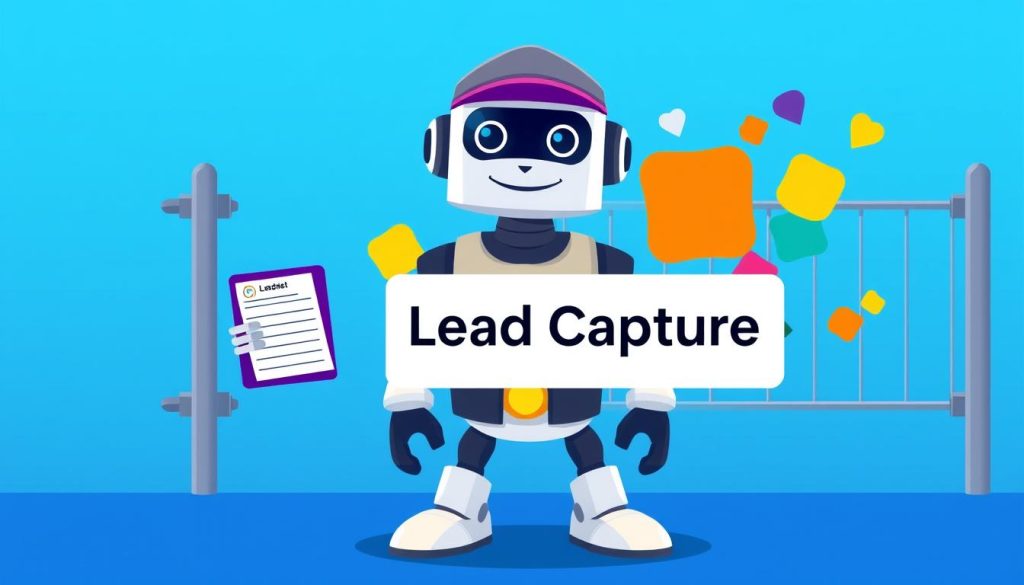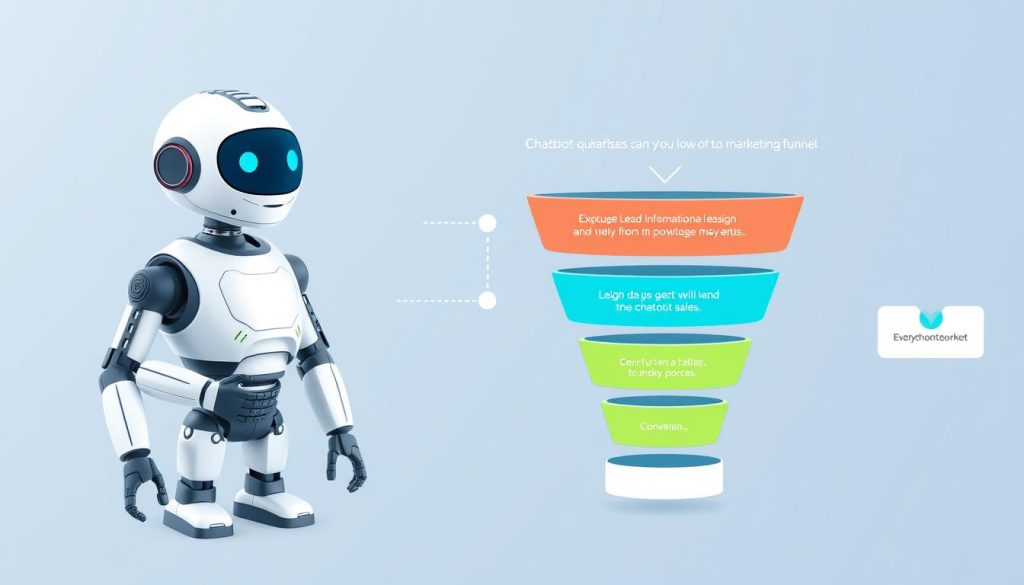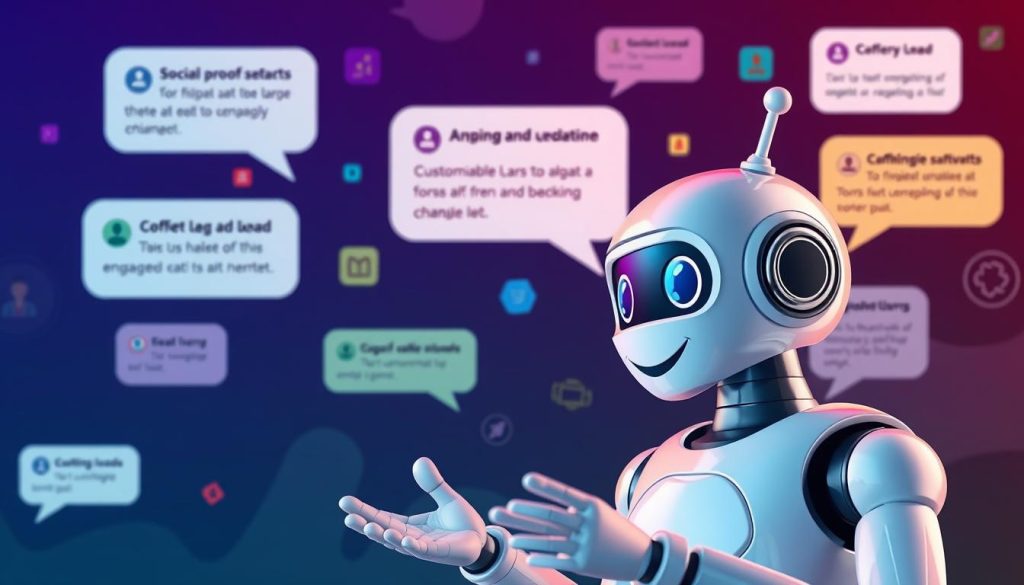In today’s digital era, lead capture has become a critical component of any successful marketing strategy. Businesses are constantly seeking innovative ways to engage with potential customers and convert them into qualified leads. Enter chatbots – intelligent conversational interfaces that are revolutionizing the way companies approach lead capture online. This comprehensive guide will explore the power of using chatbots for lead capture, delving into their benefits, key strategies, and best practices to help you maximize your online lead generation efforts.
Key Takeaways
- Chatbots are transforming the way businesses capture and engage with online leads.
- Leveraging conversational marketing through chatbots can lead to improved lead quality and increased conversion rates.
- Effective chatbot design and integration with your marketing funnel are crucial for maximizing the benefits of AI-powered sales tools.
- Measuring the success of your chatbot lead capture strategy and continuously optimizing the experience is key to long-term success.
- Selecting the right chatbot platform and addressing potential challenges are important considerations for businesses looking to implement chatbots.
What are Chatbots and How Do They Work?
In the digital age, chatbots have emerged as powerful tools for businesses to engage with their customers in more personalized and efficient ways. Chatbots are AI-powered virtual assistants that can converse with users through natural language processing (NLP) and machine learning algorithms. These innovative technologies allow chatbots to understand user queries, provide relevant responses, and even carry out tasks on behalf of the user.
Understanding the Basics of Chatbot Technology
Chatbots rely on a combination of natural language processing, machine learning, and conversational AI to deliver their functionality. By analyzing the user’s input, the chatbot can interpret the intent behind the message and formulate an appropriate response. This process involves breaking down the user’s query, identifying key entities and contextual information, and then generating a relevant and coherent reply.
The Rise of Conversational AI and Its Applications
The rapid advancements in conversational AI have led to the widespread adoption of chatbots across various industries. Chatbots are now being used for a wide range of applications, from customer service and e-commerce to marketing and lead generation. By providing instant, 24/7 support and personalized interactions, chatbots have become an essential tool for businesses to enhance the customer experience and drive engagement.
“Chatbots are the new frontier in customer service, enabling businesses to provide instant, personalized support at scale.”
| Chatbot Feature | Description |
|---|---|
| Natural Language Understanding | The ability to interpret and comprehend user inputs, even with variations in phrasing and context. |
| Conversational Flow | The capacity to engage in natural, back-and-forth dialogues, providing relevant and coherent responses. |
| Task Automation | The capability to assist users by performing specific actions or tasks on their behalf, such as scheduling appointments or placing orders. |
| Personalization | The adaptation of the chatbot’s responses and behavior to the individual user’s preferences and context. |
As the chatbot technology continues to evolve, businesses are leveraging these chatbot features to enhance customer engagement, streamline operations, and drive chatbot use cases that generate valuable outcomes.
The Benefits of Using Chatbots for Lead Capture
Integrating chatbots into your lead capture strategy can offer numerous advantages that can positively impact your business. Chatbots are available 24/7, providing instant responses and personalized interactions that can significantly improve lead engagement and conversion rates. By automating lead qualification and nurturing processes, chatbots can help you identify and prioritize high-quality leads, ultimately driving more sales opportunities.
Moreover, chatbots can gather valuable data and insights about your leads, which can be used to refine your marketing efforts and enhance the overall customer engagement. This data-driven approach allows you to better understand your target audience and tailor your lead capture efforts accordingly.
Compared to traditional lead capture methods, chatbots offer several unique benefits:
- Instant and personalized responses that improve lead engagement
- Automated lead qualification and nurturing for more efficient lead generation
- Valuable data and insights to optimize your marketing strategy
- 24/7 availability for consistent customer engagement
By leveraging the power of chatbots, businesses can streamline their lead capture processes, increase conversions, and enhance the overall customer experience. The combination of personalized interactions, data-driven insights, and round-the-clock availability makes chatbots a powerful tool for businesses looking to capture and nurture high-quality leads.

“Chatbots have become an essential tool for businesses looking to improve their lead capture and customer engagement efforts. The ability to provide instant, personalized responses and gather valuable data has made chatbots a game-changer in the digital landscape.”
Key Strategies for Effective Chatbot Lead Capture
Crafting a successful chatbot lead capture strategy requires careful planning and execution. At the heart of this process lies the design of an engaging and intuitive chatbot experience that captivates users and drives lead conversion.
Designing an Engaging and Intuitive Chatbot Experience
To create a chatbot that users will find compelling, it’s essential to focus on chatbot UX design. This involves crafting a conversational flow that is natural and responsive, anticipating user needs and providing helpful information at every step. Additionally, incorporating personalization elements, such as using the user’s name or referencing their previous interactions, can further enhance the user experience.
Leveraging Chatbot Data for Lead Qualification and Nurturing
One of the key advantages of using chatbots for lead capture is the wealth of data they can collect. By analyzing the interactions and responses within the chatbot, businesses can gain valuable insights into user intent, pain points, and purchase readiness. This data can then be used to qualify leads and create targeted lead nurturing campaigns, ensuring that your sales team receives high-quality leads that are more likely to convert.
| Chatbot Lead Capture Strategies | Key Benefits |
|---|---|
| Designing an engaging chatbot experience | Improved user engagement and lead conversion |
| Leveraging chatbot data for lead qualification | Increased sales team efficiency and lead quality |
| Implementing chatbot-driven lead nurturing | Enhanced lead conversion and customer loyalty |
“Chatbots have become a powerful tool for capturing and nurturing leads, providing businesses with a dynamic and data-driven approach to lead generation and management.”
Integrating Chatbots with Your Marketing Funnel
Seamlessly integrating chatbots into your existing marketing funnel is crucial for maximizing the impact of your lead capture efforts. By connecting your chatbots with your customer relationship management (CRM) system and marketing automation tools, you can ensure a smooth flow of lead data, enabling your sales and marketing teams to efficiently manage, nurture, and convert your chatbot-generated leads.
Connecting Chatbots to Your CRM and Marketing Automation Tools
To unlock the full potential of your chatbot lead management strategy, it’s essential to establish seamless chatbot integration with your existing CRM and marketing automation platforms. This integration allows you to:
- Automatically sync chatbot-generated leads into your CRM system, ensuring a centralized and up-to-date database of all your leads.
- Leverage your CRM data to personalize and enhance the chatbot experience, providing more relevant and targeted interactions.
- Integrate chatbot conversations and lead data into your marketing automation workflows, enabling you to nurture and convert leads more effectively.
- Generate detailed reports and analytics on the performance of your chatbot lead capture efforts, empowering you to optimize your strategies.
| Integration Benefits | Key Considerations |
|---|---|
|
|
By integrating your chatbots with your CRM and marketing automation tools, you can create a powerful and cohesive lead management ecosystem, driving greater efficiency, personalization, and ultimately, lead conversion rates.

Using Chatbots for Lead Capture Online
In the digital age, capturing qualified leads is a vital aspect of business growth. Chatbots have emerged as a powerful tool to streamline this process, offering a personalized and engaging way to connect with online visitors. Whether you’re running an e-commerce store, a professional website, or an active social media presence, chatbots can be the key to unlocking a new level of lead generation.
One of the primary advantages of using chatbots for lead capture is their ability to provide a seamless, conversational experience. Unlike traditional contact forms or lead capture forms, chatbots can actively engage with visitors, asking dynamic questions, and guiding them through the buyer’s journey. This personalized approach not only helps to qualify leads but also fosters a sense of trust and rapport, ultimately leading to higher conversion rates.
Moreover, website chatbots and e-commerce chatbots can be strategically placed throughout your online touchpoints, capturing leads at various stages of the customer funnel. From answering product-related queries on your e-commerce platform to providing personalized recommendations and support on your website, chatbots can effectively convert casual visitors into valuable leads.
By leveraging the power of chatbot lead generation, businesses can not only improve their lead capture efforts but also gain valuable insights into their target audience. The data collected through chatbot interactions can be used to refine marketing strategies, personalize the user experience, and ultimately drive business growth.
Chatbots have revolutionized the way businesses approach lead capture online, offering a more personalized and efficient way to connect with potential customers.
As the digital landscape continues to evolve, the integration of chatbots into lead capture strategies is becoming increasingly crucial. By embracing this innovative technology, businesses can stay ahead of the curve and position themselves for long-term success in the competitive online marketplace.
Best Practices for Chatbot Lead Capture
To achieve success with chatbot-driven lead capture, adherence to specific best practices is essential. Optimizing your chatbot conversations is key to maximizing lead conversion rates. By crafting engaging dialogues, providing personalized responses, and seamlessly guiding users through the lead capture process, you can ensure your chatbots deliver an exceptional user experience that drives high-quality leads.
Optimizing Chatbot Conversations for Lead Conversion
Effective chatbot conversation optimization is crucial for driving lead conversion. Here are some best practices to consider:
- Craft Compelling Dialogues: Develop chatbot conversations that are informative, engaging, and tailored to your target audience. Use natural language and conversational tone to build rapport and encourage user participation.
- Personalize the Experience: Leverage user data and context to provide personalized responses, recommendations, and lead capture forms. This enhances the user experience and increases the likelihood of conversion.
- Streamline the Lead Capture Process: Guide users through the lead capture process smoothly, minimizing friction and unnecessary steps. Ensure the chatbot provides clear instructions and seamlessly transitions users to the desired conversion action.
- Offer Relevant Incentives: Incentivize users to share their information by offering valuable content, discounts, or other benefits in exchange for their contact details.
- Continuously Optimize and Iterate: Regularly analyze chatbot performance data, user feedback, and lead conversion metrics to identify areas for improvement. Continuously refine your chatbot conversations and lead capture strategies to enhance their effectiveness.
| Best Practice | Description | Impact on Lead Conversion |
|---|---|---|
| Engaging Dialogues | Develop informative and conversational chatbot interactions | Increases user engagement and encourages lead capture |
| Personalized Experience | Tailor responses and lead capture forms based on user data | Enhances the user experience and boosts lead conversion rates |
| Streamlined Process | Minimize friction and unnecessary steps in the lead capture flow | Improves conversion rates by reducing user abandonment |
| Relevant Incentives | Offer valuable content, discounts, or other benefits to users | Encourages users to share their information and increases lead capture |
By implementing these best practices for chatbot lead capture and chatbot conversation optimization, you can effectively drive lead conversion and create a positive user experience that ultimately benefits your business.

Measuring the Success of Your Chatbot Lead Capture Strategy
Evaluating the performance of your chatbot lead capture strategy is crucial for identifying areas of improvement and driving continuous optimization. Tracking the right chatbot lead capture metrics and key performance indicators (KPIs) can provide invaluable insights into the effectiveness of your approach and help guide your future decisions.
One of the most important metrics to monitor is your lead conversion rate – the percentage of users who engage with your chatbot and ultimately become qualified leads. This data can help you assess the quality of the leads generated through your chatbot and make adjustments to improve the conversion process.
Additionally, measuring customer satisfaction through feedback and ratings can shed light on the overall user experience and identify opportunities to enhance your chatbot’s design and functionality. Analyzing these data analysis insights can inform your optimization efforts and ensure your chatbot lead capture strategy aligns with your business objectives.
| Metric | Description | Importance |
|---|---|---|
| Lead Conversion Rate | The percentage of users who engage with the chatbot and become qualified leads. | Helps evaluate the quality and effectiveness of the lead capture process. |
| Customer Satisfaction | Measures user satisfaction with the chatbot experience through feedback and ratings. | Identifies areas for improvement and ensures the chatbot is providing a positive user experience. |
| Return on Investment (ROI) | Calculates the financial return generated by the chatbot lead capture strategy. | Demonstrates the overall impact and value of the chatbot investment to the business. |
By closely monitoring these chatbot lead capture metrics and KPIs, you can make data-driven decisions to optimize your chatbot lead capture strategy, enhance the user experience, and drive meaningful business results.
“Measuring the success of your chatbot lead capture strategy is not just about numbers, it’s about understanding the user experience and how your chatbot is contributing to your overall business goals.”
Popular Chatbot Platforms and Tools
In the ever-evolving world of digital marketing, chatbots have emerged as a powerful tool for lead capture and customer engagement. With a wide range of chatbot platforms and chatbot tools available, businesses are spoilt for choice when it comes to selecting the right solution for their needs. From feature-rich enterprise-level platforms to user-friendly DIY chatbot builders, the market offers a diverse array of chatbot features and chatbot selection options.
Evaluating Different Chatbot Solutions for Your Business Needs
When it comes to choosing the right chatbot platform or chatbot tool for your business, it’s essential to consider a range of factors, including chatbot features, integration capabilities, pricing, and overall user experience. To help you navigate the chatbot selection process, here’s a quick overview of some of the most popular and feature-rich solutions on the market:
- Dialogflow (formerly API.AI) – A comprehensive chatbot platform from Google that offers natural language processing, intent recognition, and integration with various messaging channels.
- Amazon Lex – A chatbot tool from Amazon Web Services that leverages the same deep learning technologies used in Alexa, providing a scalable and customizable chatbot solution.
- IBM Watson Assistant – A powerful chatbot platform that combines natural language understanding, dialog management, and integration capabilities to create intelligent conversational experiences.
- Botkit – An open-source chatbot tool that provides a flexible framework for building and deploying chatbots across a variety of messaging platforms.
When evaluating different chatbot solutions for your business, it’s essential to assess your specific chatbot features and lead capture requirements, as well as consider factors such as integration, scalability, and overall user experience. By taking the time to carefully consider your options, you can ensure that you select the right chatbot platform or chatbot tool to meet your business objectives.

Overcoming Challenges and Addressing Concerns
While chatbots offer numerous benefits for lead capture, businesses may face some challenges and concerns when implementing this technology. These include data privacy issues, ethical considerations, and difficulties with chatbot integration. However, with the right strategies and best practices, these obstacles can be overcome, ensuring a successful chatbot lead capture initiative that aligns with your company’s values and regulatory requirements.
Data Privacy Concerns
One of the primary concerns with chatbots is the handling of sensitive user data. Businesses must ensure that they comply with data privacy regulations, such as the General Data Protection Regulation (GDPR) and the California Consumer Privacy Act (CCPA), and that they have robust data security measures in place to protect customer information.
Ethical Considerations
The use of chatbots also raises ethical considerations, such as the transparency of their capabilities and the potential for bias or discrimination in their decision-making processes. Businesses must be mindful of these concerns and develop chatbots that are transparent, unbiased, and aligned with their ethical principles.
Chatbot Integration Difficulties
Integrating chatbots with existing marketing and customer service systems can also be a challenge. Businesses must ensure that their chatbots seamlessly integrate with their Customer Relationship Management (CRM) tools, marketing automation platforms, and other relevant systems to provide a consistent and efficient customer experience.
To overcome these challenges, businesses should:
- Implement robust data privacy and security measures to protect customer information
- Develop chatbots that are transparent about their capabilities and decision-making processes
- Ensure that their chatbots are unbiased and aligned with their ethical principles
- Carefully plan and execute the integration of their chatbots with their existing marketing and customer service systems
By addressing these concerns and implementing best practices, businesses can harness the power of chatbots for effective lead capture while maintaining the trust and confidence of their customers.
| Challenge | Description | Strategies for Overcoming |
|---|---|---|
| Data Privacy Concerns | Ensuring compliance with data privacy regulations and securing customer information | Implement robust data privacy and security measures, such as encryption, access controls, and data minimization |
| Ethical Considerations | Ensuring chatbots are transparent, unbiased, and aligned with ethical principles | Develop chatbots with clear transparency about their capabilities and decision-making processes, and ensure they are unbiased and aligned with your company’s ethical principles |
| Chatbot Integration Difficulties | Seamlessly integrating chatbots with existing marketing and customer service systems | Carefully plan and execute the integration of chatbots with CRM tools, marketing automation platforms, and other relevant systems to provide a consistent and efficient customer experience |
Conclusion
In the ever-evolving digital landscape, the power of chatbots for lead capture online has become undeniable. By harnessing the capabilities of conversational AI, businesses can unlock a new era of customer engagement and lead conversion, driving sustainable growth and maintaining a competitive edge.
As the use of chatbot lead capture continues to rise, embracing this transformative technology has become crucial. By understanding the intricacies of online lead generation and implementing effective strategies, businesses can design engaging and intuitive chatbot experiences that captivate their target audience.
Looking ahead, the future of conversational marketing holds immense potential. As the future of chatbots unfolds, businesses that stay ahead of the curve and seamlessly integrate these powerful tools into their marketing funnel will be poised for long-term success. By continuously optimizing chatbot performance and leveraging the invaluable data they provide, organizations can unlock new levels of lead qualification and nurturing, ultimately driving sustainable growth and customer loyalty.




